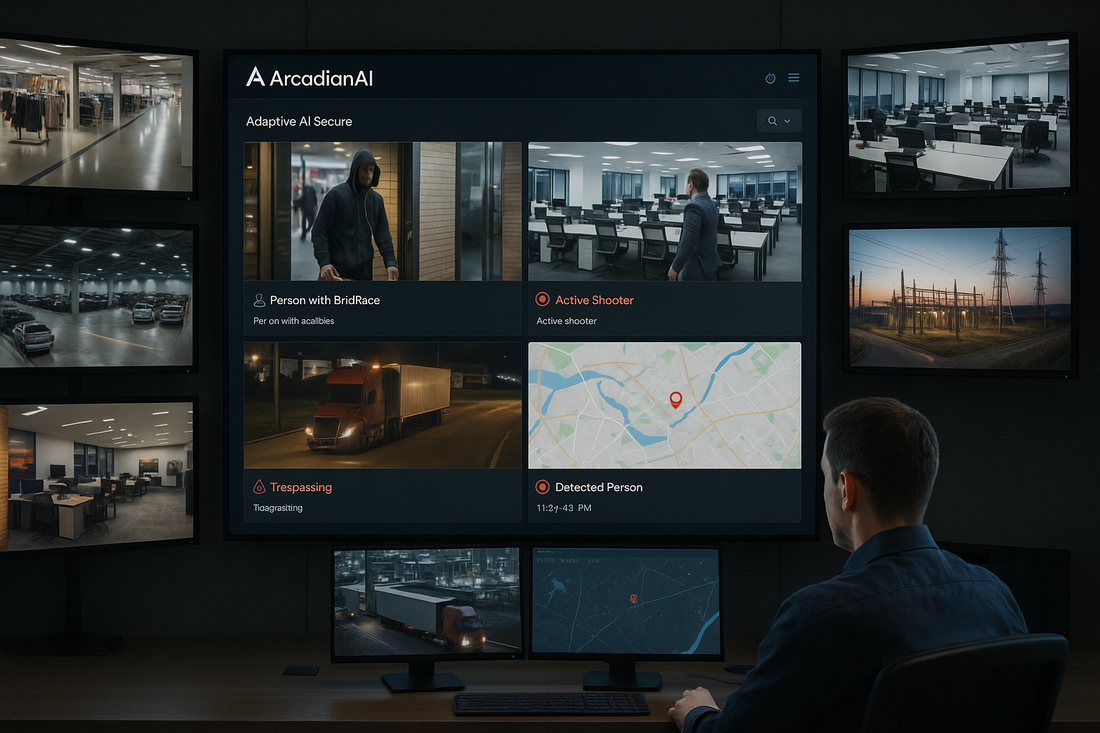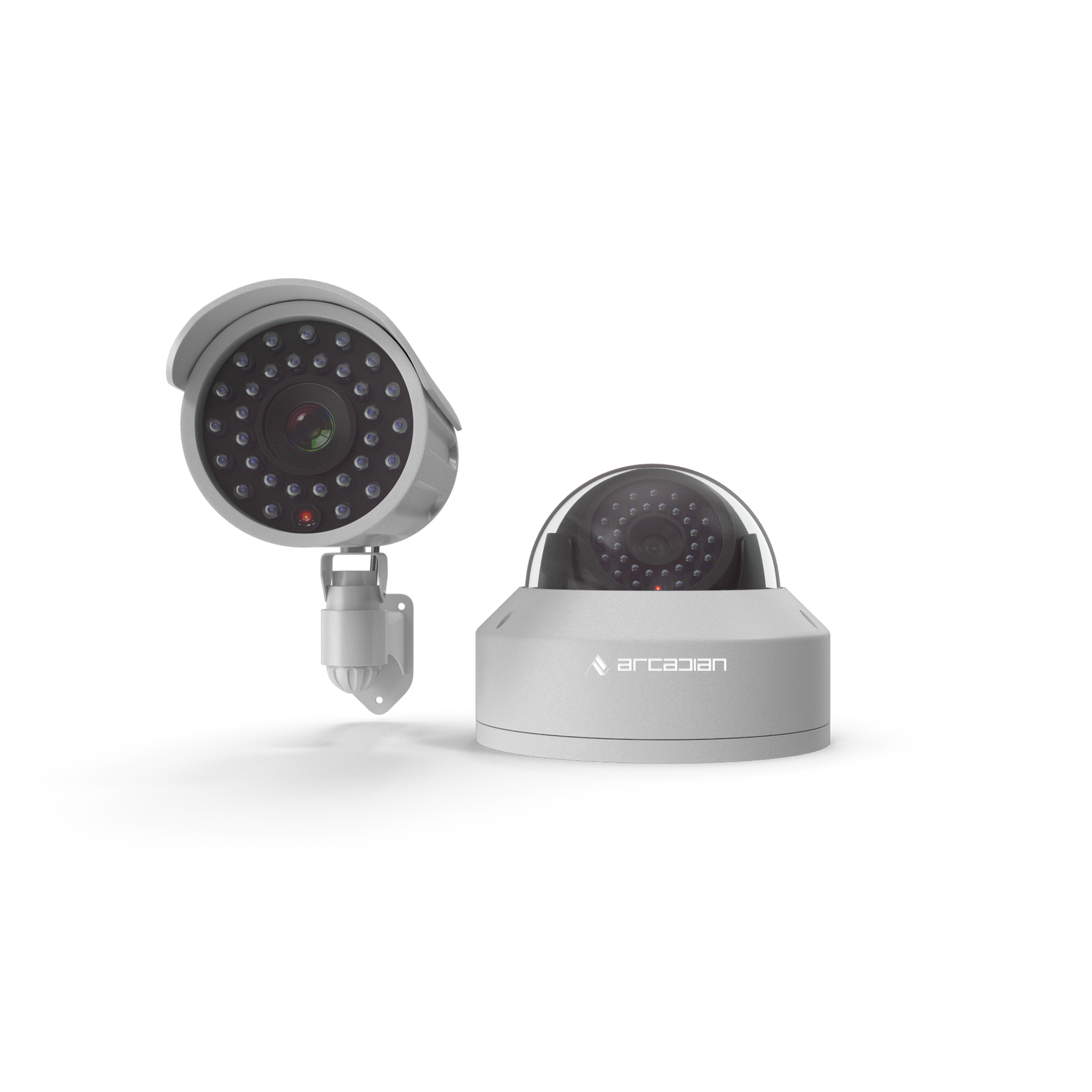8 Physical Security Trends Defining 2025: Why Adaptive AI Is No Longer Optional
From AI-driven surveillance to ESG compliance, 2025 is rewriting the playbook for physical security. Here are the eight trends reshaping the industry—and why ArcadianAI Ranger is the must-have evolution beyond Verkada, Genetec, and Eagle Eye Networks.

Introduction
Physical security in 2025 isn’t static—it’s a moving target. Organizations face a convergence of risks: organized retail crime (ORC) up 19% in 2024 (NRF), active shooter incidents rising 15% in the U.S. (FBI, 2024), and hybrid workplaces doubling security spend (Gartner, 2025). Legacy vendors like Verkada, Genetec, and Milestone continue to package traditional video analytics under the “AI” label, but businesses are finding the limitations painful: false alarms, blind spots, and non-adaptive insights.
ArcadianAI enters as the evolution. With Ranger, our adaptive AI assistant, organizations finally move beyond static surveillance toward context-aware, dynamic intelligence that learns from every location. Two Starbucks stores in different neighborhoods may look similar to a camera, but Ranger understands the unique behaviors of each.
This blog dives deep into the 8 physical security trends that will define 2025, explains why legacy providers can’t keep up, and shows how ArcadianAI’s adaptive AI delivers ROI, compliance, and resilience.
Quick Summary / Key Takeaways
-
AI-first security replaces static video analytics in 2025.
-
NVR obsolescence accelerates with cloud-native surveillance.
-
Organized retail crime (ORC) forces smarter loss prevention.
-
Compliance & ESG drive vendor decisions more than price.
-
ArcadianAI Ranger provides adaptive, camera-agnostic intelligence.
Background & Relevance
Physical security used to be “gates, guards, and guns.” By 2025, it’s cloud, compliance, and AI. Why the shift?
-
$150B global market by 2026 — physical security spend continues to climb (MarketsandMarkets, 2024).
-
Hybrid work reshaping risks — 72% of global companies now support hybrid models (Gartner, 2025).
-
Compliance pressures — NDAA bans on Hikvision/Dahua continue to ripple, GDPR fines grow, ESG reporting expands.
-
Retail shrink crisis — Walmart, Target, and CVS reported combined $121B losses in 2024 (NRF).
Competitors like Eagle Eye Networks push cloud VMS, while Genetec leans into hybrid models. But both miss the next evolution: adaptive AI that contextualizes video and creates actionable intelligence for security leaders and CFOs alike.
Core Exploration — The 8 Trends
1. AI-Driven, Adaptive Surveillance Becomes the Default
The shift: Video analytics once meant detecting objects or motion. In 2025, enterprises expect systems to understand context.
-
Legacy providers like Verkada market “AI,” but their models are static—trained once, deployed everywhere, blind to local variations.
-
Adaptive AI like ArcadianAI Ranger evolves per location, minimizing false alarms. A “loitering” alert in a New York bodega is different from one in a suburban Walmart.
-
Competitors like Rhombus, Nest, and Ring remain consumer-focused and lack enterprise-grade adaptability.
👉 Impact: By 2026, 60% of enterprises will demand adaptive AI features in surveillance procurement (Gartner, 2025).
2. Cloud-Native Security Accelerates the Demise of NVRs
The shift: NVRs (network video recorders) are losing ground to cloud-native surveillance.
-
IDC 2024 reports that 70% of enterprises plan to phase out NVRs by 2027.
-
Eagle Eye Networks leads cloud VMS adoption, but requires vendor hardware.
-
Verkada’s cloud-hardware bundle creates vendor lock-in—customers can’t escape without ripping everything out.
-
ArcadianAI is camera-agnostic: customers can keep Axis, Hanwha, Hikvision, or existing cameras while gaining AI-driven insights in the cloud.
👉 ROI: Organizations save 50% in infrastructure costs by moving away from NVR-heavy models.
3. Retail Crime & ORC Surge Drives Smarter Loss Prevention
The shift: Retailers face a crisis in 2025.
-
19% increase in organized retail crime in 2024 (NRF).
-
CVS closed 300+ stores in 2024 citing theft and safety risks.
-
Walmart and Target now demand AI-based security reports for loss prevention teams.
Competitor systems (Genetec, Milestone) provide video after the fact. Ranger gives real-time theft detection, collusion monitoring, and forensic analytics that connect theft patterns across multiple stores.
👉 Example: A retailer using ArcadianAI reduced shrink by 27% in six months by identifying repeat ORC teams across different city stores.
4. ESG & Compliance Now Dictate Vendor Choices
The shift: ESG reporting and compliance laws make security procurement as much about governance as threats.
-
NDAA bans Chinese OEMs like Hikvision/Dahua in U.S. federal procurement.
-
GDPR fines hit record levels in 2024 (€2.9B in penalties).
-
Environmental requirements now extend to surveillance: energy-efficient AI and serverless cloud adoption are part of ESG audits.
👉 Why ArcadianAI? Unlike Hikvision/Dahua, ArcadianAI’s Ranger is built on North America-compliant infrastructure, NDAA-ready, and designed for minimal energy impact.
5. Critical Infrastructure & IoT Convergence
The shift: Oil & gas, utilities, and logistics industries demand IoT + AI fusion.
-
Mobile security trailers from Zedcor and LVT dominate field deployments but lack real adaptive AI.
-
ArcadianAI integrates with Immix, RapidSOS, and SCADA systems, giving operators cross-sensor intelligence.
-
Example: A Texas oil company used Ranger to correlate camera alerts with IoT sensors detecting pipeline pressure anomalies.
👉 Result: Reduced false positives by 42% and cut incident response times in half.
6. Insider Threats & Workplace Violence
The shift: Not all threats come from the outside.
-
Ponemon 2024: Insider threats cost enterprises $16.2M annually on average.
-
Ranger detects unusual staff access, collusion, and after-hours anomalies.
-
Competitors focus only on video playback, missing behavioral analytics.
👉 Example: A logistics provider identified collusion between staff and external thieves using Ranger’s multi-camera behavioral correlation.
7. Hybrid Work & Multi-Site Security Complexity
The shift: Security leaders now oversee hundreds of distributed offices, warehouses, and stores.
-
72% of companies globally support hybrid work (Gartner).
-
Genetec and Milestone require site-by-site integration, costing enterprises millions in setup fees.
-
ArcadianAI consolidates all cameras and data into one adaptive dashboard, while providing per-site context.
👉 Benefit: Security operations centers (SOCs) gain one unified, adaptive view—whether monitoring a hospital campus in Boston or a logistics warehouse in Dallas.
8. Security ROI Becomes a Boardroom Metric
The shift: Security is no longer just cost—it’s ROI.
-
Allied Market Research: Every $1 invested in security saves $6.50 in avoided loss.
-
CFOs now demand security analytics as part of financial planning.
-
Ranger generates board-ready reports, transforming security from cost center to business value driver.
👉 Key takeaway: Legacy vendors provide video. ArcadianAI provides data, analytics, and ROI justification.
Comparisons & Use Cases
| Vendor | Model | Lock-In Risk | AI Capability | ROI Impact | Compliance Focus |
|---|---|---|---|---|---|
| Verkada | Cloud HW/VMS | High | Static analytics | Medium | NDAA concerns |
| Genetec | Hybrid VMS | Medium | Rules-based | Medium | High |
| Eagle Eye | Cloud VMS | Medium | Basic object detect. | Medium | Medium |
| Milestone | On-prem VMS | High | Plugin-based | Low | Medium |
| ArcadianAI | Ranger AI | None | Adaptive contextual | High | Strong compliance |
Common Questions (FAQ)
Q1. What is the #1 physical security trend of 2025?
Adaptive AI surveillance that learns context, reducing false alarms.
Q2. Why are NVRs being phased out?
They lack scalability, compliance readiness, and AI integration.
Q3. How does ArcadianAI compare to Verkada?
ArcadianAI is camera-agnostic, adaptive, and compliance-ready. Verkada is hardware-locked with static analytics.
Q4. Is AI security affordable for SMBs?
Yes. Cloud-native AI reduces upfront costs by 50% versus legacy VMS.
Q5. What industries benefit most in 2025?
Retail, healthcare, logistics, utilities, education, and smart cities.
Conclusion & CTA
2025 is the year adaptive AI replaces static security. Enterprises that cling to legacy NVRs, outdated VMS, or “AI-washed” analytics risk higher losses, compliance penalties, and operational blind spots.
ArcadianAI Ranger delivers:
-
Adaptive AI that learns per site.
-
Cloud-native, camera-agnostic deployment.
-
Compliance and ESG alignment.
-
ROI-focused analytics for boards and CFOs.
👉 See ArcadianAI in Action → Get Demo – ArcadianAI
Security Glossary (2025 Edition)
Adaptive AI — Machine learning that adjusts to environment and behavior, cutting false alarms.
AI Alerts — Notifications generated by contextual AI, not rigid rules.
Axis Communications — Leading camera manufacturer, NDAA-compliant.
CCPA (California Consumer Privacy Act) — U.S. regulation on data protection.
Cloud VMS — Cloud-hosted video management platform.
Eagle Eye Networks — U.S.-based cloud VMS provider.
ESG (Environmental, Social, Governance) — Corporate reporting framework driving security procurement.
Genetec — Canadian hybrid VMS provider for enterprise.
Hybrid Work Security — Solutions protecting remote + office employees.
Milestone Systems — On-premises VMS vendor with plugin-based analytics.
NDAA Compliance — U.S. ban on Chinese-made surveillance hardware.
NVR (Network Video Recorder) — Legacy on-site video storage hardware.
ORC (Organized Retail Crime) — Coordinated theft targeting retailers.
Ranger (ArcadianAI) — Adaptive AI platform unifying surveillance into contextual intelligence.
Retail Shrink — Inventory loss from theft, error, or fraud.
Verkada — U.S. vendor bundling cameras with proprietary cloud VMS.
VSaaS (Video Surveillance as a Service) — Subscription-based cloud video monitoring.

Security is like insurance—until you need it, you don’t think about it.
But when something goes wrong? Break-ins, theft, liability claims—suddenly, it’s all you think about.
ArcadianAI upgrades your security to the AI era—no new hardware, no sky-high costs, just smart protection that works.
→ Stop security incidents before they happen
→ Cut security costs without cutting corners
→ Run your business without the worry
Because the best security isn’t reactive—it’s proactive.







